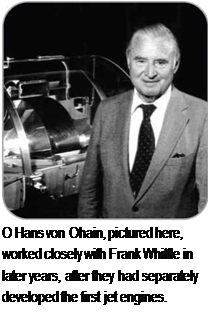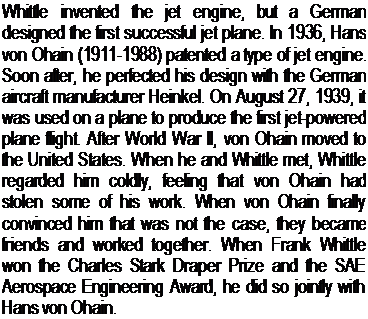Whittle, Frank
Date of birth: June 1, 1907.
Place of birth: Coventry, England.
Died: August 9, 1996.
Major contributions: Invented the jet engine; built a jet engine used in an airplane that set speed and altitude records. Awards: Knight of the Order of the British Empire; Albert Medal; Order of Merit; Charles Stark Draper Prize; SAE Aerospace Engineering Award.
|
T |
he son of a mechanic, Frank Whittle joined the British Royal Air Force (RAF) at the age of sixteen. His work with model airplanes caught the eye of an officer who recommended him for officer training. During training, Whittle wrote a detailed essay about the possibility of developing a new kind of aircraft engine that would not turn a propeller. He wrote that planes could reach higher altitudes and faster speeds if exhaust from the engine provided the thrust.
Higher-ranking officers dismissed Whittle’s ideas, but he continued to pursue them. His initial plan used a piston to compress air, but he concluded that such an engine would weigh too much. Whittle developed a new approach using a turning turbine. Once again, however, his superiors rejected the idea. In 1930, Whittle patented the idea himself.
Little happened with Whittle’s idea until he was approached six years later by Rolf Dudley- Williams and James Tinlin, about the possibility of developing his engine. The three formed a company-Power Jets Limited-in 1936 and began work on building a model of Whittle’s
engine plans. On April 12, 1937, they tested the engine, which was mounted on a stand on the ground. It worked perfectly. A scientist who learned of the success convinced the RAF to provide funding to develop an airplane that used the new engine.
That work took place slowly. A successful test of a newer version of the engine in 1939 spurred quicker work. The prototype plane, built by Gloster, arrived late in 1940, and Whittle built the engine at Power Jets facilities. The engine was tested successfully late in 1940. On May 15, 1941, the Gloster plane, with Whittle’s engine inside, flew for 17 minutes. It reached a top speed of 340 miles per hour (545 kilometers per
hour). The success convinced RAF officials to move ahead with the aircraft.

 |
In 1944, the British government took control of Whittle’s company. In 1948, Whittle resigned from the company and from the RAF due to ill health. For the next twenty years or so, he worked as a consultant for various companies. Some of his work focused on jet engines. Whittle also designed a new kind of drilling head for oil drills. In 1976, he moved to the United States, where he taught at the U. S. Naval Academy.










